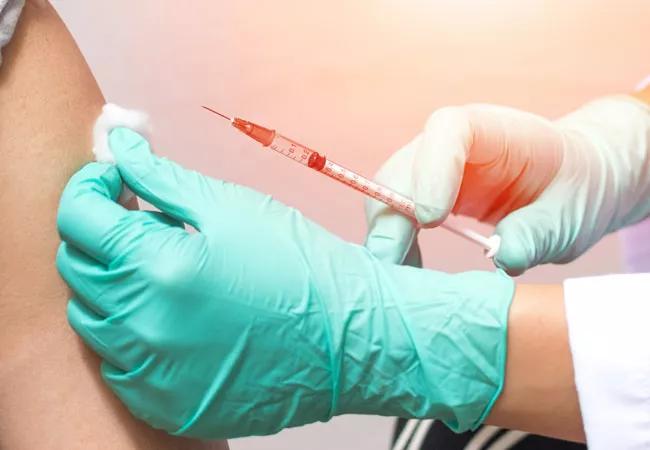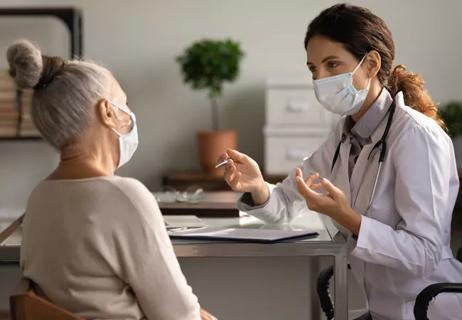Key steps to optimizing clinician-patient communication

Cleveland Clinic is a non-profit academic medical center. Advertising on our site helps support our mission. We do not endorse non-Cleveland Clinic products or services. Policy
*Please note this is an abridged version of an article originally published in the Cleveland Clinic Journal of Medicine. For the full article, including a complete list of references, please visit https://www.ccjm.org/content/87/9/545.
We have a safe and effective cancer-prevention vaccine, but widespread vaccination remains a challenge in the U.S. Patients may have concerns about vaccine safety and efficacy due to mixed messages from the media and other sources, but other common reasons for not vaccinating are provider discomfort in discussing sexuality, not receiving a strong recommendation from the clinician, and the belief by both the patient and provider that the patient is not at high risk.
Similarly, a survey of guardians in a Texas school district (a state where the vaccination rate is < 50%) identified scheduling conflicts and the lack of vaccine recommendation from a healthcare provider as significant hurdles to vaccination. Even in a New York school district that permitted adolescent vaccine self-consent, scheduling and returning for the appointment were significant challenges affecting the vaccination rate.
Key steps to implementing successful HPV vaccination in practice include understanding the individual patient’s risk, following recommended vaccination timelines (which allow some flexibility with scheduling), and optimizing clinician-patient communication.
Any patient who is sexually active is at risk for HPV-related cancer. Approximately 80% of individuals will become infected with HPV at some point in their life, and HPV is the most common sexually transmitted disease in the U.S.
Yet despite how common HPV infection is, many women do not think that they are at risk. According to a survey of more than 900 unvaccinated females age 15 to 24, this belief was a main reason for forgoing vaccination (both in women who were and were not sexually active).
For women who have sex with women, HPV can live on sexual devices for more than 24 hours. In addition to discussing the importance of vaccination, they should be counseled to use a barrier method over any shared sexual devices and clean the devices appropriately after each use.
In the U.S., HPV vaccination is routinely recommended to all adults until age 26, although the vaccine can be offered until age 45 in select patients who are not immunized. However, the vaccine is most likely to be beneficial when the series is completed before sexual debut; thus, guidelines recommend starting vaccination at age 11 to 12, with the option to start as early as age 9.
Clinicians may not feel comfortable discussing topics related to sexuality, especially in the field of pediatrics. A survey of members within four California chapters of the American Academy of Pediatrics showed that 71% of pediatricians would feel more comfortable discussing vaccination if the conversation also included education about HPV-related head and neck cancers.
California Chapter 3 of the American Academy of Pediatrics created a 22-minute clinician training video that includes clinical vignettes of pediatricians counseling families who had concerns about vaccination (available at: https://aapca3.org/hpv-videos-education-promotion-project/). After watching this video, surveyed clinicians were shown to have improved their knowledge of vaccine safety, HPV disease burden (especially for males), and the importance of not delaying vaccination beyond preadolescence. This brief video intervention also led to more providers feeling “very comfortable” advising families.
Another study looked at the most effective way to educate patients. A randomized controlled trial of three patient counseling strategies — an eight-minute educational video (n = 87), an educational handout with the same information written at an eighth-grade reading level (n = 84), and usual care (n = 85) — was performed to assess vaccine acceptance. More patients in the educational video arm agreed to have the HPV vaccine (51.7%) than in the handout or control arms (33.3% and 28.2%, respectively, P < .01). Interestingly, both the video and handout helped increase knowledge similarly, although the video helped most for the patient’s decision to be vaccinated.
In my practice, I start by notifying the patient that they are due for their HPV vaccine, just as I would do with any other preventive recommendation (e.g., need for blood testing, cancer screening). Many patients will agree to this simple approach without a need for a long discussion about risks versus benefits, which may, paradoxically, lead to a greater hesitation to be vaccinated.
Next, I clarify that the goal of HPV vaccination is to prevent cancer, and I remind the patient that everyone who engages in sexual activity is at risk. For those who have more concerns, it is important to first understand what the specific barriers are before trying to address them.
Despite our best efforts to educate, some patients may decline vaccination. It is important to avoid thinking of this as “losing a battle,” as respecting patient autonomy ensures not only a trusted partnership in the patient’s future healthcare, but also helps to minimize clinician frustration. Patients may opt to go against our recommendations in multiple situations, and they will make their own life decisions no matter how hard we try to provide optimal care.
Given that scheduling conflicts seem to play a prominent role in nonadherence to vaccination schedules, some flexibility with appointments is key. Anyone age 15 or older will need three doses of the HPV vaccine, typically with the second dose given one to two months after the first, and the third within six months of the first (at 0, 1–2, and 6 months). To accommodate a patient’s schedule, the second HPV vaccination can be scheduled at four weeks after the first dose, and the third dose 12 weeks after the second. There should be at least five months between the first and third dose (referred to as the “minimal interval”).
If repeat vaccination has occurred any earlier than these minimal intervals, then the patient will need another dose after the appropriate minimal interval has passed. Caution with interval dates is needed only when patients wish to come in earlier than recommended; if the vaccine schedule is interrupted or delayed, then a patient can continue with the remainder of the routine recommended schedule; no additional boosters or schedule adjustments are required (no maximum interval).
In Australia, where the HPV vaccine was made available for free in a national school program, vaccination rates of more than 70% have been achieved nationally in girls ages 12 to 13, with resultant clinical benefits in preventing both warts and precancerous lesions. A meta-analysis of nine high-income countries suggested that HPV infections decreased most when there is at least 50% coverage of the female population. In addition to Australia, Denmark, Canada (Quebec province) and New Zealand have offered widespread vaccination to multiple age cohorts, leading to optimized population immunity and the maximum impact on clinical outcomes.
Vaccination rates vary greatly among U.S. states. In contrast to the 78% vaccination rate in Washington, DC, which has a mandate for school entry, the Mississippi rate is only 29%. As of 2019, only three states provide free HPV vaccination through their health departments, although 25 states have laws requiring some funding for HPV education and vaccination.
Of note, in the U.S., there has been a higher uptake of the HPV vaccine among minority patients (higher in Hispanic and Black versus white populations) and also in those within a lower socioeconomic status group (income below federal poverty level, and having Medicaid coverage as opposed to private insurance). Because these populations of women historically have been at higher risk for HPV-related disease and cancer, it is hoped that this may lead to reversing some of these healthcare disparities.
In the U.S., significant controversy surrounds the idea of mandating vaccination prior to starting school, limiting vaccine exemptions, and the perceived loss of an individual’s autonomy. Although a rise in vaccine-preventable illnesses has been seen primarily in communities with lower rates of vaccination, asking school administrators and nurses to “police” who is allowed to return to school adds an extra layer of complexity to this heated debate.
Although many may disagree with me, I suspect the best path to improving vaccination rates will not be achieved by adding more laws and rules, but by improving the education of both patients and caregivers, establishing a trusting patient-doctor relationship, simplifying office workflows (empowering nursing teams to educate patients, and then prompting clinicians that the vaccine order is needed), and by lifting financial barriers to vaccination, including copays, prior authorization, and coverage ambiguity.
For a complete list of references, please visit: https://www.ccjm.org/content/87/9/545

How we create obstacles for sexual, reproductive and menopausal healthcare despite our best intentions

One approved non-hormonal therapy and another on the horizon reduce vasomotor symptoms

Some post-menopausal patients may benefit from treatment

Study shows higher rates of complications, laparotomies among non-white women

Proper diagnosis and treatment require a careful mix of patient and clinical considerations

Study uniquely powered to compare adverse effects

What is female hypoactive sexual desire disorder and how is it treated?

Indications and best-practice recommendations for the use of androgen therapy